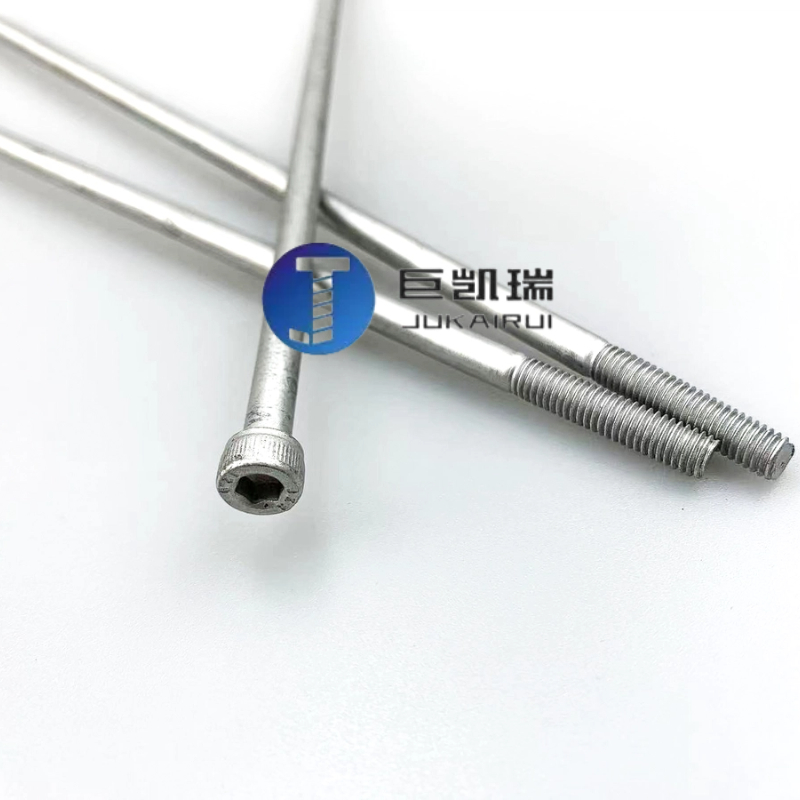Release time:2020-01-16 18:44 Browse:

In daily life and industrial production, screws are widely used as fasteners, and they bear the heavy responsibility of connecting and fixing various components. However, with the passage of time and the change of the use environment, screw loosening has become a common and cannot be ignored. Especially in the need to withstand a large tensile force, shear force or vibration force, the loosening of the screw not only affects the normal operation of the equipment, but also may cause safety accidents. Therefore, it is particularly important to understand and master how to avoid loosening the lengthening screws. This paper will discuss this problem from the aspects of design, installation, maintenance and selection of materials.
1. Reasonable design and selection
First of all, to avoid the loosening of the lengthening screws should be grabbed from the source, that is, to fully consider its use environment at the design stage. According to the actual application scenario, choosing the right screw type, specification and material is the key. For example, in a vibration environment, priority should be given to locking screws with self-locking functions, such as nylon locking screws or screws with special coatings, which are designed to resist vibration induced loosening to a certain extent. At the same time, the diameter, depth and thread form of the screw hole are reasonably designed to ensure the tight fit of the screw and the screw hole and reduce the possibility of loosening.
Two, the correct installation method
Every detail in the installation process is directly related to the fastening effect of the screws. The following points should be paid special attention to when installing lengthening screws:
1. ** Cleaning work ** : Before installation, be sure to ensure that the screws, screw holes and their surrounding environment are clean, without oil, impurities, etc., so as not to affect the fit degree of screws and screw holes.
2. ** preload control ** : Use the appropriate tool (such as torque wrench) to tighten the screw according to the specified torque value, to avoid too tight resulting in screw damage, or too loose resulting in loosening. For important parts, step tightening method can be used, that is, pre-tighten first, and then gradually increase the torque to the specified value.
3. ** Cross tightening ** : For parts that are jointly tightened with multiple screws, the principle of cross tightening should be followed, that is, first tighten diagonally, and then gradually move closer to the center to ensure uniform force and reduce loosening caused by local stress concentration.
3. Effective anti-loosening measures
In addition to design and installation considerations, some additional anti-loosening measures can be taken to enhance the stability of the extension screw:
1. ** Lock washer ** : The use of spring washer, lock washer and other auxiliary components, through its elastic or locking mechanism, increase the friction between the screw and the screw hole, to prevent loosening.
2. ** Thread locking agent ** : Apply appropriate amount of thread locking agent between the screw and the thread of the screw hole, and form a high-strength bonding layer after curing to effectively prevent loosening. When selecting the locking agent, it is necessary to select the appropriate type and strength level according to the use environment and requirements.
3. ** Mechanical locking device ** : such as the use of locking disc, locking pin and other mechanical devices, the screw and parts or other structural parts are directly connected to increase additional locking force, suitable for high vibration, high impact environment.
Iv. Regular inspection and maintenance
Even with all the above measures, regular inspection and maintenance is still an important part of keeping the screws tight. Regularly check whether the screws are loose, worn or damaged, and replace or re-tighten them in time, which can effectively prevent problems caused by screw loosening. In addition, for equipment that operates in a high-load and high-vibration environment for a long time, the inspection cycle should be shortened and maintenance should be strengthened.
5. Material selection and surface treatment
The choice of materials and surface treatment also have an important impact on the fastening performance of screws. The screws made of high-strength and corrosion-resistant materials can better resist the influence of the external environment and extend the service life. At the same time, special treatment of the screw surface, such as galvanized, dacromet, etc., can improve its corrosion resistance and wear resistance, and further reduce the risk of loosening.
To sum up, avoiding the loosening of lengthening screws is a systematic project, which needs to be comprehensively considered from many aspects such as design, installation, maintenance, material selection and anti-loosening measures. Only by achieving excellence in every link can we ensure that the screws maintain a stable fastening state in the complex and changing use environment, and provide a strong guarantee for the normal operation of the equipment.
# Lengthening screws # Lengthening bolts # Lengthening outer hex screws # Lengthening inner hex screws # fasteners

